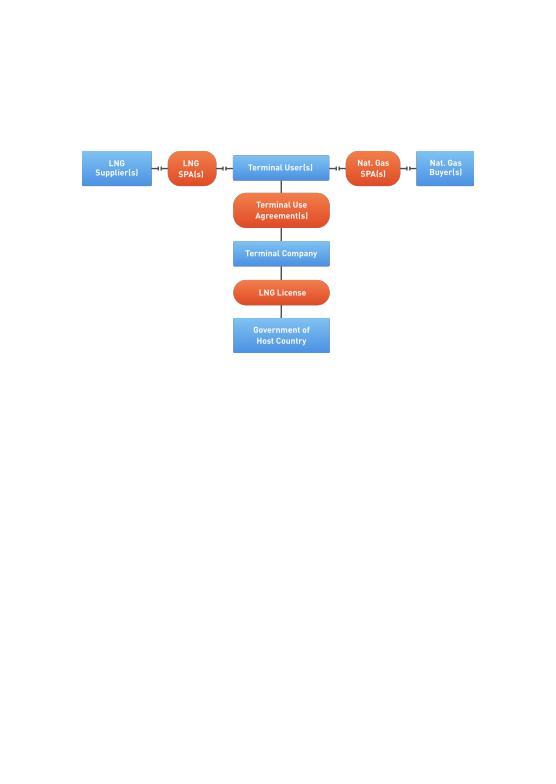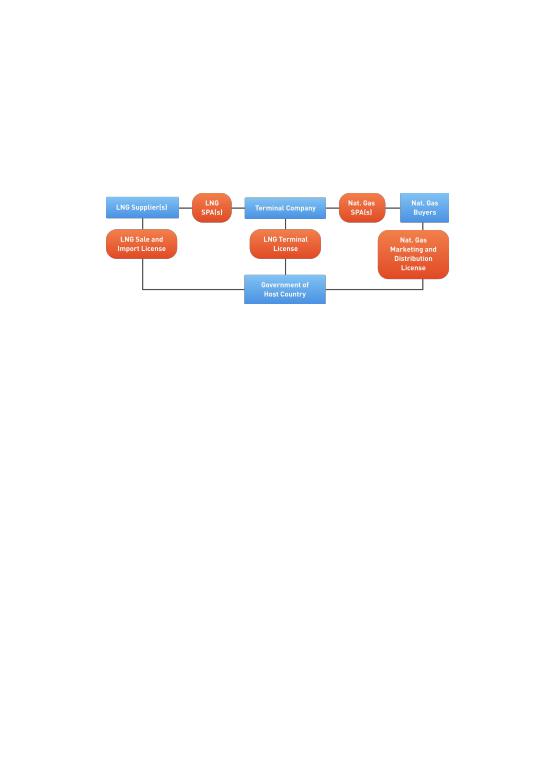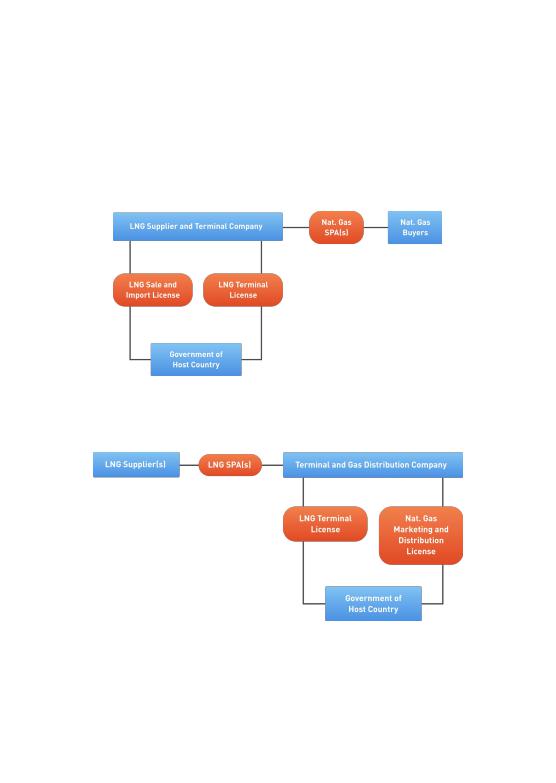
01 POWER ISLAND / 01 CCPP / DOE__Understanding Natural Gas and Lng Options October 11 2017_1
.pdf
LNG IMPORT PROJECTS
Import Commercial Structuring
Introduction
Project structuring is a critical element of a successful LNG import project. Given the magnitude of the required capital investment and the length of the period of commercial operations, the risks associated with each import project and the functions for the project participants need to be carefully defined and allocated in order to allow debt to be paid off and to generate sufficient returns for investors. Structuring an import project correctly from its inception is important in order to anticipate project risks over time, to avoid misalignments between stakeholders, and mitigate other risks to the project's success.
The structure chosen for each LNG import project will have ramifications for the allocation of the project's risks and the roles of the various project participants. It will also have an impact on whether the project is able to attract further equity investors, if needed, and raise debt funding from financiers. The structure can impact project agreement pricing and financing costs because the allocation of risk generally involves a rate-of- return or pricing tradeoff.
Choosing a Commercial Structure
As with LNG export projects, three basic forms of commercial structures have emerged for LNG import projects - tolling, merchant and integrated. There are hybrid variations of these three models and the potential exists for further changes in the future, but these three structures are the basic prevailing structures currently being used for LNG import projects.
206

LNG IMPORT PROJECTS
Tolling Commercial Structure
Under the LNG import tolling commercial structure, the user or users of the LNG import terminal are different entities than the owner of the LNG import terminal. The LNG terminal company need not buy LNG or sell natural gas, but rather provides regasification services (without taking title to the natural gas or LNG) under one or more long-term terminal use agreements. The LNG terminal company revenues are derived from tariff payments paid to the LNG terminal company by the terminal users. The payments typically take the form of a two-part tariff: (1) fixed monthly payments cover the LNG terminal company's debt service, return of and on equity, and fixed operation and maintenance costs, and (2) variable regasification service payments are designed to cover the terminal company's variable operation, maintenance and other costs, such as the terminal's power costs. Because the functions of the LNG terminal company generally do not include a commodity merchant function, the LNG terminal company does not bear material commodity merchant risks such as the supply, demand, and cost of LNG and natural gas. The credit of the terminal user or users provides the financial underpinning for the LNG terminal company. Import project tolling structure examples include the Sabine Pass, Freeport, Cameron and Cove Point LNG import projects in the U.S., the UK's South Hook LNG import project, and Italy's Adriatic LNG import project.
207

LNG IMPORT PROJECTS
The tolling commercial structure as applied to LNG import projects may be illustrated as follows:
Merchant Commercial Structure
Under the LNG import merchant commercial structure, the LNG supplier and the natural gas marketing or distribution company are different entities than the owner of the LNG import terminal. The LNG import project company purchases LNG from the LNG supplier under a long-term LNG sale and purchase agreement, and sells regasified LNG to the natural gas marketing or distribution company, or directly to a power station, under a long-term natural gas sale and purchase agreement. The LNG import project revenues are derived from the amount by which the revenues from natural gas sales exceed the sum of the cost of regasification (including debt service) and LNG procurement costs. Because the LNG supplier is a different entity than the owner of the LNG import project, there may be more than one supplier of LNG to the LNG import project company, and because the natural gas marketing or distribution company is a different entity than the owner of the LNG import terminal, there may be more than one purchaser of natural gas from the LNG import project company. The credit of both the LNG supplier or suppliers and the natural gas purchaser or purchasers provides the financial underpinning for the LNG import project.
208

LNG IMPORT PROJECTS
Merchant structure examples include the U.S. Everett Massachusetts LNG import project, India's Petronet Dahej and Kochi LNG import projects, and Shell's Hazira LNG import project in India. The merchant commercial structure for LNG import projects is illustrated in the diagram below.
Integrated Commercial Structure ("Merchant +")
The project development for this structure is the same as under the Merchant Structure, except that the terminal is owned by an entity that undertakes a wider role in the LNG chain; e.g. a power plant (TEPCO) or a gas distribution company (Tokyo Gas) or the LNG export company (e.g. RasGas for the Adriatic LNG Terminal). The ultimate commodity sold may be the product of the company; thus gas, power or steel, as in the case of Tokyo Gas, TEPCO or Pohang Iron and Steel Company (Posco), respectively. As with the development under the Merchant Structure, a FEED package is developed, sent out for bid, and an EPC contract award is made to the successful bidder after all commercial agreements and permits are in place and a FID has been taken. After completion of the terminal by the EPC contractor, the terminal is commissioned and placed in service. Under the LNG import integrated commercial structure, the owner of the LNG import facilities is also either the LNG supplier or the natural gas marketing or distribution company (or perhaps a power producer). The project revenues for both commercial functions are integrated into one entity such that there is no need for an LNG SPA for delivery at the terminal with respect to integrated structures that combine the LNG supply and import terminal functions. There is no need for a natural gas sale and purchase agreement for delivery at the tailgate of the terminal with respect to integrated structures that combine the import terminal and natural gas marketing or distribution functions (and perhaps the associated power producer function).
209

LNG IMPORT PROJECTS
Because the LNG supplier or the natural gas distribution or marketing company is the same entity as the owner of the LNG import terminal, there is typically no other user of the LNG import terminal. Examples of the integrated commercial structure for LNG import projects are reflected in the diagrams below.
Upstream integrated structure:
Downstream: integrated structure
210

LNG IMPORT PROJECTS
Hybrid Structures
Hybrid structures combining some of the attributes of tolling, merchant, and integrated models may be used to tailor LNG import projects to the characteristics and needs of particular host governments and project participants. For example, hybrid merchant-tolling structures may be used to allow the LNG import project company to take title to the LNG and sell natural gas, but receive fixed monthly reservation charges regardless of whether their customers utilize regasification services and actually import LNG.
211

LNG IMPORT PROJECTS
Commercial Structure Checklist
Commercial |
Advantages |
Disadvantages |
|
Structure |
|
|
|
|
|
|
|
Tolling |
Known and commonly used structure |
Requires scheduling alignment |
|
|
familiar with LNG industry participants |
of not only the LNG SPA and |
|
|
No price or market risk for the LNG import |
natural gas SPA but also the |
|
|
project company or its project finance lenders |
tolling agreement |
|
|
Allows ownership in the LNG terminal |
Need to determine |
|
|
company to be different from ownership in the |
competitiveness of price of the |
|
|
LNG supplier or natural gas marketing or |
tolling services |
|
|
distribution company |
Unbundling terminal services |
|
|
|
from commodity/sales services |
|
|
|
reduces commercial efficiency |
|
|
|
|
|
Merchant |
The terminal user merchant function is |
Requires additional project |
|
|
aligned with the terminal owner and operator |
agreements |
|
|
function because they are performed by the |
Requires negotiation of LNG or |
|
|
same entity |
regas transfer price |
|
|
Flexibility to allow non-LNG supplier or |
Project financing must address |
|
|
natural gas distribution investors in the |
risks associated with the |
|
|
project company |
commodity merchant function |
|
|
|
|
|
Integrated |
Commercial parties are perfectly aligned |
Complex to include other |
|
|
along the value chain |
entities |
|
|
No need to determine a transfer price |
Project financing must address |
|
|
|
risks associated with the non- |
|
|
|
import integrated function |
|
|
|
|
|
Government |
Owner (government) has full control |
Government may lack |
|
Owned |
|
experience in developing, |
|
|
|
marketing and operating LNG |
|
|
|
import facilities |
|
|
|
Government responsible for |
|
|
|
100% of equity and equity risk |
|
|
|
|
|
212

LNG IMPORT PROJECTS
Driving Factors in Choice of Structure
There are a number of key driving factors that influence the choice of an LNG import project structure for the host government, the investors, the natural gas buyer(s), the project lenders and the other project stakeholders. Some of these key driving factors include:
>Legal regime and taxes: The host country legal regime and local taxes often have a major impact on project structure. An LNG import project may fall under different legal regimes in the host country, depending on whether it is integrated with LNG supply or gas distribution functions, acts as a merchant, or acts solely as a terminal owner and operator, e.g. general corporate regime, special mid-stream regime or downstream regime. Additionally, the tax rates may differ for LNG importing, terminal operation, and natural gas marketing and distribution.
>Governance: The government, local stakeholders, lenders and the LNG buyers may desire to have more of a direct say in the internal governance and decision making in one import function than another import function. This needs to be reflected in the structure selected. A poorly governed structure in any of the LNG supply, terminal ownership and operation, or natural gas distribution components of the LNG import chain can lead to conflicts among the parties and impact the efficiency and reliability of the LNG import project.
>Efficient use of project facilities: The LNG import project structure should encourage efficient use of all project facilities and activities by the project owners and by third parties. In determining the optimal project structure for LNG imports, consideration should be given to the costs and benefits of sharing common facilities, open access to third parties for spare capacity, and reduction of unnecessary facilities and their related costs.
>Flexibility in Ownership: There may be a desire by the government, other local stakeholders, LNG buyers, or lenders (e.g. IFC) to have a direct ownership interest in all or specified portions of the LNG import chain. Alternately, some of the participants in the commodity chain may not be interested in owning an interest in the LNG terminal company. The choice of a particular structure can enable different levels of ownership in companies performing different components of the LNG import chain.
213

LNG IMPORT PROJECTS
>Desire for Limited Recourse Financing: In general, the cost and complexity of project finance are reduced when the functions and risks of the project company borrower are reduced. Consequently, utilizing an LNG import project tolling structure should facilitate project financing by shifting commodity merchant functions and risks away from the terminal company.
>Operational Efficiencies: The integrated structure offers operational efficiencies because only one operator is involved in construction, operating and scheduling activities. The operational inefficiencies of having two operators may be overcome through transparency and coordination between the operators. In addition, separate projects can lead to project-on-project risk i.e. where one project is ready before the other or a default relating to one project jeopardizes another project.
>Regulations: The choice of project structure will affect the required regulations.
>LNG and Gas transfer prices: The LNG transfer price is the price of LNG sold by the LNG supplier or suppliers to the terminal company in a merchant structure. The natural gas transfer price is the price of natural gas sold by the terminal company to the natural gas buyer or buyers in a merchant structure. These are often contentious commercial points. In addition, each segment of the gas value chain may fall under a different tax regime such that the prices may need to comply with an arm’s length standard to comply with tax transfer pricing laws and regulations.
214

LNG IMPORT PROJECTS
Commercial Agreements
Introduction
LNG import projects require different types of contracts at different stages in the LNG import value chain. While a significant number of these contracts are negotiated between private parties, some of the most important ones involve host governments or may be regulated by the host government.
In that context, an understanding of the different types of contracts, their place in the LNG import value chain, and the development of the project, are important. Particular attention should be paid to the technicality and complexity of these contracts. The objective is that governments can prepare effectively for these negotiations, build necessary knowledge to make informed decisions and create dedicated negotiations teams. Contract implementation is an equally important area for host governments to build capacity and dedicate resources.
This section aims at providing an overview of the different types and categories of contracts in order to enable governments to prepare accordingly.
LNG Sale and Purchase Agreement
The LNG Sale and Purchase Agreement (SPA) needed for the LNG feedstock for an LNG import project utilizes the same form of agreement discussed in the chapter entitled LNG Sale and Purchase Agreement. The LNG purchaser will, of course, try to negotiate any project-specific terms and conditions in the SPA.
It should be noted that, from the perspective of the project company, an LNG SPA will not be needed in the integrated LNG import commercial structure, which includes the upstream and/or liquefaction developer, or in an integrated tolling LNG import commercial structure. In these structures, the user of the LNG import project already has title to LNG.
215
